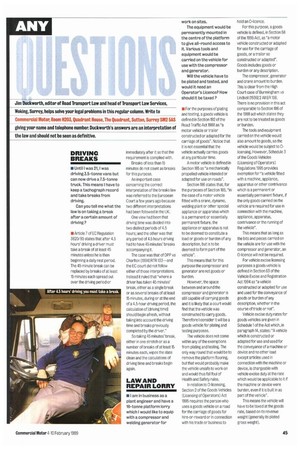LAW AND REPAIR LORRY
Page 47

If you've noticed an error in this article please click here to report it so we can fix it.
• i am In business as a plant engineer and have a 16-tonne platform lorry which I would like to equip with a compressor and welding generator for work on sites.
The equipment would be permanently mounted in the centre of the platform to give all-round access to it. Various tools and equipment would be carried on the vehicle for use with the compressor and generator.
Will the vehicle have to be plated and tested, and would It need an Operator's Licence? Flow should it be taxed ?
• For the purposes of plating and testing, a goods vehicle is defined in Section 192 of the Road Traffic Act 1988 as "a motor vehicle or trailer constructed or adapted for the carriage of goods". Notice that it is not essential that the vehicle actually carries goods at any particular time.
A motor vehicle is defined in Section 185 as "a mechanically propelled vehicle intended or adapted for use on roads".
Section 186 states that, for the purposes of Section 185, "in the case of a motor vehicle fitted with a crane, dynamo, welding plant or other special appliance or apparatus which is a permanent or essentially permanent fixture, the appliance or apparatus is not to be deemed to constitute a load or goods or burden of any description, but is to be deemed to form part of the vehicle".
This means that for this purpose the compressor and generator are not goods or burden.
However, the space between and around the compressor and generator is still capable of carrying goods and it is likely that a court would find that the vehicle was constructed to carry goods. Therefore I consider it will be a goods vehicle for plating and testing purposes.
The vehicle does not come within any of the exemptions from plating and testing. The only way round that would be to remove the platform flooring, but that would probably make the vehicle unsafe to work on and would thus fall foul of Health and Safety rules.
In relation to 0-licensing, Section 2 of the Goods Vehicles (Licensing of Operators) Act 1995 requires the person who uses a goods vehicle on a road for the carriage of goods for hire-or-reward or in connection with his trade or business to hold an 0-licence.
For this purpose, a goods vehicle is defined, in Section 58 of the 1995 Act, as "a motor vehicle constructed or adapted for use for the carriage of goods, or a trailer so constructed or adapted". Goods includes goods or burden or any description.
The compressor, generator and crane amount to burden. This is clear from the High Court case of Birmingham Vs Lindsell [1936] 2 All ER 159. There is no provision in this act comparable to Section 186 of the 1988 act which states they are not to be treated as goods or burden.
The tools and equipment carried on the vehicle would also amount to goods, so the vehicle would be subject to °licensing. However, Schedule 3 of the Goods Vehicles
(Licensing of Operators) Regulations 1995 provides exemption for "a vehicle fitted with a machine, appliance, apparatus or other contrivance which is a permanent or essentially permanent fixture, if the only goods carried on the vehicle are required for use in connection with the machine, appliance, apparatus, contrivance or the running of the vehicle".
This means that as long as the bits and pieces carried on the vehicle are for use with the compressor and generator, an 0-hcence will not be required.
For vehicle excise licensing purposes a goods vehicle is defined in Section 63 of the Vehicle Excise and Registration Act 1994 as "a vehicle constructed or adapted for use and used for the conveyance of goods or burden of any description, whether in the course of trade or not".
Vehicle excise duty rates for goods vehicles are given in Schedule 1 of the Act which, in paragraph 14, states: "A vehicle which is constructed or adapted for use and used for the conveyance of a machine or device and no other load except articles used in connection with the machine or device, is chargeable with vehicle excise duty at the rate which would be applicable to it if the machine or device were burden, even if it is built in as part of the vehicle".
This means the vehicle will have to be taxed at the goods rate, based on its revenue weight (generally its plated gross weight).








































































































